A recent article explored the question “Why does craft matter in a digital age” The insights there are worth a look. Here are some snipets from artists trying to explain: Craft is “a way of thinking”, “beyond the cerebral… and through our hands”, “it slows everything down”, “it’s close to the body”. Japanese glass artist, Yoshiaki Kojiro: “Craft is an event that starts with a physical sense of relationship between materials and people.”
 All this and more fascinates me for the Creation account in Genesis 2 has God Himself getting his hands into the dirt, in time, on the ground to make things. Then we are tasked, after His exampling, to make things. It’s in the making that seeing is enhanced. It’s in the time taken and slowed down where relationships are better understood. It’s work, but strangely hope-filled.
All this and more fascinates me for the Creation account in Genesis 2 has God Himself getting his hands into the dirt, in time, on the ground to make things. Then we are tasked, after His exampling, to make things. It’s in the making that seeing is enhanced. It’s in the time taken and slowed down where relationships are better understood. It’s work, but strangely hope-filled.
Yet conversely, in what we call ‘real life’ we talk of “sound bites” and “visual grabs”, about “fake news” and “photo-shopped reality”. All the while we’re racing past what is real, missing the bigger things worth considering that will last all this.
I have been crafting. I’m working on a large oil on paper piece for a show. If I can get it where I want it, I’ll show it here first, maybe in the next post. I also have been crafting a small book. I pressed “approve” this morning, and soon this webpage will offer it for your consideration. The reason for the writing (and it’s taken 6 long years) is because the One who got His own hands into the dirt moved me to take the materials within my grasp of understanding and see if I could make something of it.
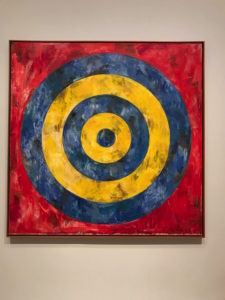 Jasper Johns’ 66 inch square piece is showcased at the Art Institute of Chicago and it jogged some thought. Johns’ intention when he made this and several other target images in the 60’s, was that viewers would see something familiar, “something the mind already knows” as a bridge or a catalyst toward further meaning. He was using the known to pry loose more that is not yet grasped.
Jasper Johns’ 66 inch square piece is showcased at the Art Institute of Chicago and it jogged some thought. Johns’ intention when he made this and several other target images in the 60’s, was that viewers would see something familiar, “something the mind already knows” as a bridge or a catalyst toward further meaning. He was using the known to pry loose more that is not yet grasped. 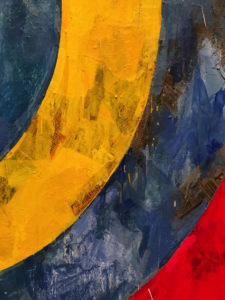
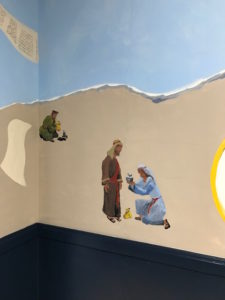 .
.



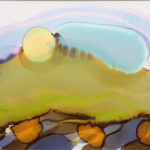 I will end the year with a simple post and a simple piece. After the workshop I taught, putting materials away, I decided to play on my own just a bit more. This one is a success and I matted it with an Emily Dickinson poem I have loved:
I will end the year with a simple post and a simple piece. After the workshop I taught, putting materials away, I decided to play on my own just a bit more. This one is a success and I matted it with an Emily Dickinson poem I have loved: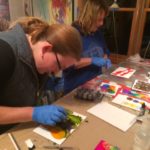
 Voila, or “There it is!” was the result after a couple hours of experimentation. We really are creative whether we understand how we’re made or not. The excitement in getting a glimpse of that is contagious. This finished result was just one of several little gems made that night. Liz illuminated a favorite quote from Brenda Ueland’s “If You Want to Write”: “Since you are like no other being ever created since the beginning of time, you are incomparable.”
Voila, or “There it is!” was the result after a couple hours of experimentation. We really are creative whether we understand how we’re made or not. The excitement in getting a glimpse of that is contagious. This finished result was just one of several little gems made that night. Liz illuminated a favorite quote from Brenda Ueland’s “If You Want to Write”: “Since you are like no other being ever created since the beginning of time, you are incomparable.”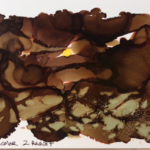
 I am inserting here two little experiments with some inks for a workshop I’ll be conducting next week. Beginners will be introduced to some of the rationale behind abstraction’s promise. If some good work shows up from some of these craftsmen, I’ll be sure to post.
I am inserting here two little experiments with some inks for a workshop I’ll be conducting next week. Beginners will be introduced to some of the rationale behind abstraction’s promise. If some good work shows up from some of these craftsmen, I’ll be sure to post.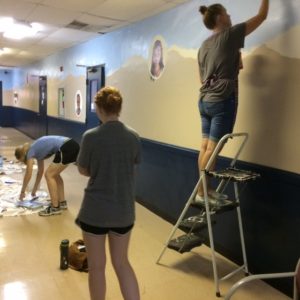 In some previous posts, I’ve highlighted the portrait work begun this summer for a community space, an after school refuge for kids. On a recent Saturday, a group of us gathered for several hours to paint in a basic background to set the avatars into a landscape. This entire tableau is going to be a storied timeline, further to be detailed and linked. Do I sound like I know what I’m doing? I laugh at the thought and my own chutzpah. I’ve never tackled something this big! But the stars aligned this year for the project. The ideas clicked, the grant money provided, the kids showed enthusiasm, and the time came available soon after I was asked to consider spearheading the venture. It’s going to come to a unified completion with a little help from friends. It’s way better together. Our goal is to have these two long hallway walls completed with all the elements by Christmas.
In some previous posts, I’ve highlighted the portrait work begun this summer for a community space, an after school refuge for kids. On a recent Saturday, a group of us gathered for several hours to paint in a basic background to set the avatars into a landscape. This entire tableau is going to be a storied timeline, further to be detailed and linked. Do I sound like I know what I’m doing? I laugh at the thought and my own chutzpah. I’ve never tackled something this big! But the stars aligned this year for the project. The ideas clicked, the grant money provided, the kids showed enthusiasm, and the time came available soon after I was asked to consider spearheading the venture. It’s going to come to a unified completion with a little help from friends. It’s way better together. Our goal is to have these two long hallway walls completed with all the elements by Christmas.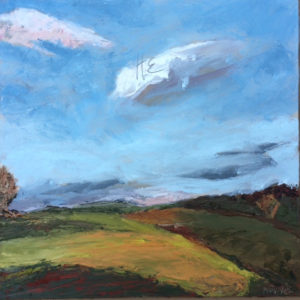 The small painting inserted here got finished today. It is one from the series I mentioned last post. Looking up is not the anesthesia of escape artists. It is rather a choice, based on sure evidence made more necessary in darkening times. It looks
The small painting inserted here got finished today. It is one from the series I mentioned last post. Looking up is not the anesthesia of escape artists. It is rather a choice, based on sure evidence made more necessary in darkening times. It looks 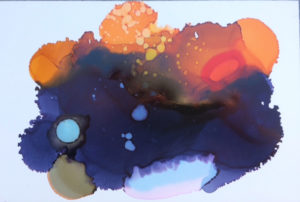 I struggle with my own voice in my work, living as I do in such a time of disintegration. I cannot make the work of my hands “say” what I hold in my heart so often. It is not my goal to be literal, but it is a desire to lift the viewer’s eyes. A friend of mine who is a photographer, grieving deeply over the death of her husband is now doing the best work of her career. We talked of this: why are we doing this work, this searching with images? Is it meaningful, is it what we “should be doing”? We got this far in our discussion: this work is an exploration into JOY. This expression is as fleeting as a sunset and as mysterious as a bird’s flight, but it is necessary, if even just for us. I have some ability to look, and to craft. Maybe through the work of my own hands others will see meaningfully also. For this, I keep on.
I struggle with my own voice in my work, living as I do in such a time of disintegration. I cannot make the work of my hands “say” what I hold in my heart so often. It is not my goal to be literal, but it is a desire to lift the viewer’s eyes. A friend of mine who is a photographer, grieving deeply over the death of her husband is now doing the best work of her career. We talked of this: why are we doing this work, this searching with images? Is it meaningful, is it what we “should be doing”? We got this far in our discussion: this work is an exploration into JOY. This expression is as fleeting as a sunset and as mysterious as a bird’s flight, but it is necessary, if even just for us. I have some ability to look, and to craft. Maybe through the work of my own hands others will see meaningfully also. For this, I keep on.
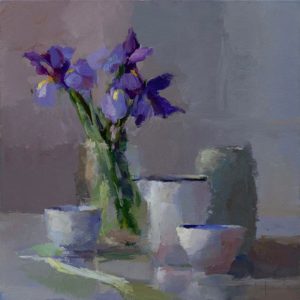 The settings are dim, completely uninteresting on their own. So, the piercing bits of beauty are apprehended all the more. Her gestural gems are gathered out of mud. It’s the boring that gives the beauty its chance to captivate. To me her work is a parable, a picture of the distinctiveness between that which shines, and that which is only a passing setting.
The settings are dim, completely uninteresting on their own. So, the piercing bits of beauty are apprehended all the more. Her gestural gems are gathered out of mud. It’s the boring that gives the beauty its chance to captivate. To me her work is a parable, a picture of the distinctiveness between that which shines, and that which is only a passing setting.